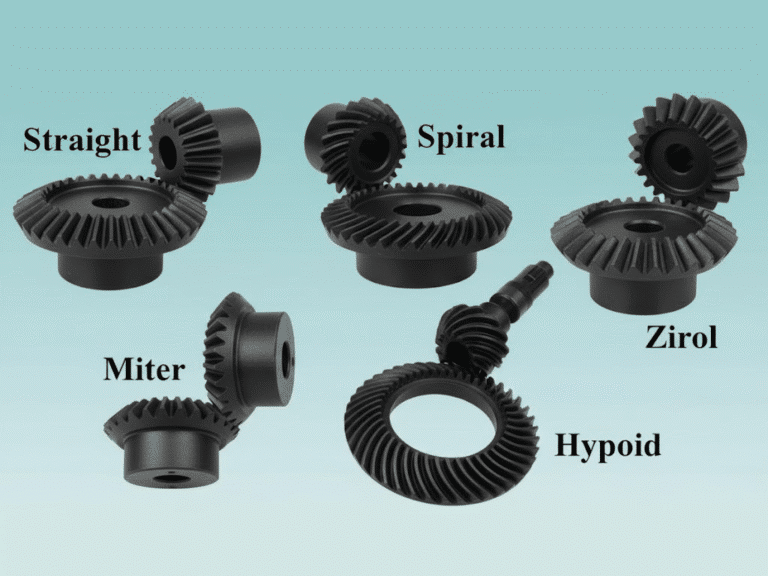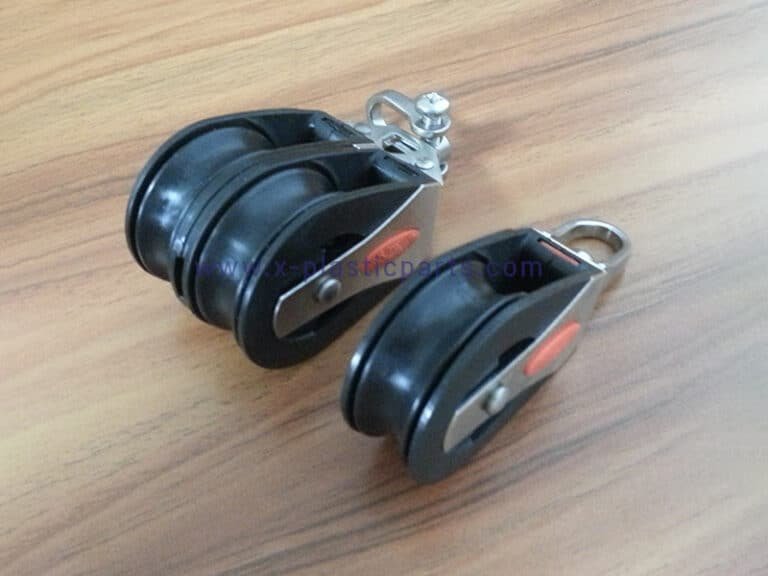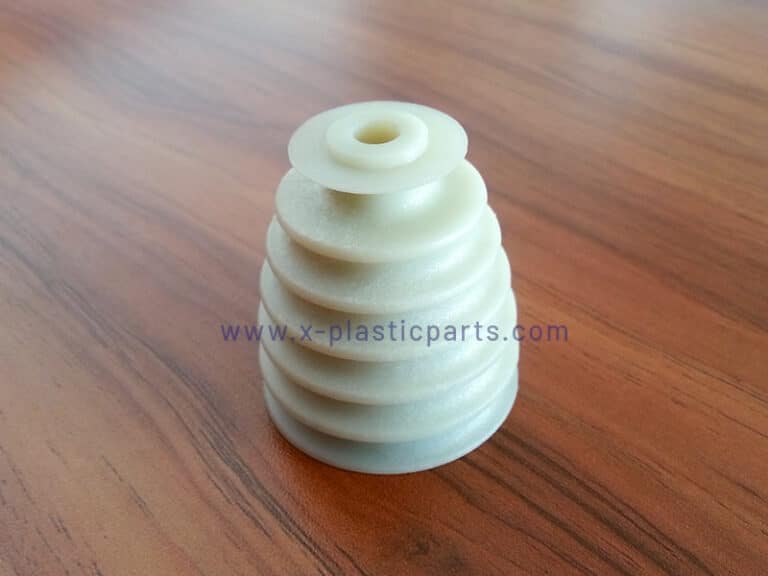A bevel gear is a type of gear used to transmit power between intersecting shafts. It is a conical gear with teeth cut on a conical surface, allowing rotation to change direction, often at 90 degrees. Structural features include a cone-shaped body where the teeth taper toward the apex. The role of bevel gears is to transfer torque and motion efficiently in systems where shafts are not parallel. They appear in automotive differentials, industrial machinery, and power tools. This article covers types, efficiency factors, structure, design parameters, advantages, disadvantages, manufacturing processes, and selection guidelines for bevel gears.
Types of Bevel Gears
Bevel gears come in several types, each with distinct characteristics and suitable applications:

Straight Bevel Gears
These have straight, tapered teeth cut along the gear’s conical pitch surface. They are typically mounted on shafts at 90 degrees in the same plane. Because of their simple design, they are easier to manufacture but tend to produce more noise and vibration at high speeds. They are suited for low-speed applications such as printing machines, hand drills, and differential mechanisms.
Spiral Bevel Gears
These gears have curved teeth set at an angle, enabling gradual tooth engagement that reduces noise and vibration. Spiral bevel gears support higher load capacities and run more smoothly than straight bevel gears. They work well in high-speed, high-torque situations, like automotive differentials, helicopter transmissions, and high-performance industrial machinery.
Zerol Bevel Gears
Zero-bevel gears have curved teeth with a zero-degree spiral angle. They combine features of straight and spiral types, offering moderate thrust loads and stable transmission. These conical gears are used in power tools and machine tools that require direction changes and longer service life.
Hypoid Bevel Gears
Hypoid bevel gears use hyperbolic pitch surfaces and offset shafts. They handle high torque in compact spaces with quiet performance. Common in vehicle rear axles, they fit applications needing non-intersecting shafts and efficient power distribution.
Miter Gears
Miter gears are a special case of bevel gears where both gears have the same number of teeth, typically mounted at right angles. They merely change the direction of rotation without altering speed or torque and are utilized in clocks, robotic joints, and optical instruments.

Factors Affecting Gear Efficiency
Efficiency in bevel gears depends on several factors. These can be listed as follows:
- Tooth contact ratio: A higher tooth contact ratio distributes load across multiple teeth, reducing wear and enhancing smoothness.
- Pressure angle: The pressure angle, typically 20 degrees, balances force distribution and tooth strength for efficient power transfer.
- Lubrication quality: Proper lubrication quality minimizes friction and heat generation, maintaining efficiency up to 98 percent.
- Alignment accuracy: Accurate alignment prevents uneven load distribution, which reduces performance and causes premature wear.
- Operating speed: Operating speed affects efficiency, with spiral bevel gears performing better at high speeds due to smoother meshing.
- Material wear: Material wear resistance ensures gears maintain performance over time, preventing efficiency loss from degradation.
- Backlash control: Controlled backlash provides space for lubrication without excessive play, ensuring efficient power transmission.
Structure and Key Design Parameters
The structure of a bevel gear is defined by a truncated conical body (or blank), the pitch cone, which establishes the theoretical meshing surface, and a mounting hub for shaft attachment.
Its design is governed by a series of key geometric parameters: the number of teeth determines the speed ratio; the Module or Diametral Pitch defines the tooth size and strength; the Pitch Angle sets the cone shape to ensure correct meshing at intersecting axes; and the Pressure Angle, along with the Face Width, influences the tooth root strength and contact area. Furthermore, the Contact Ratio is a critical performance indicator for operational smoothness and noise reduction, while precise Mounting Distance and engineered Backlash are the final assembly requirements for reliable operation and long-term durability.
Advantages and Disadvantages of Bevel Gear
Bevel gears offer several advantages and disadvantages that are important to consider when selecting these components for mechanical systems.
Advantages of Bevel Gears
Efficient Power Transmission: Bevel gears provide efficient transfer of power between shafts at various angles, typically 90 degrees. Their design minimizes energy loss during transmission, making them effective for precise power transfer.
Compact Design: The conical shape of bevel gears allows them to fit in confined spaces better than many other gear types. This compactness is beneficial in machinery where space is limited.
Versatility: Bevel gears are available in straight, spiral, hypoid, and miter types, each designed for different load and speed needs, making them adaptable to diverse mechanical applications.
High Load Capacity: Especially spiral bevel gears have a higher load-carrying capacity compared to spur gears, allowing them to be used in heavy-duty applications like automotive differentials and industrial machinery.
Directional Change: Bevel gears are specifically designed to change the axis of rotation, commonly at right angles, which is essential in many mechanical transmissions.
Disadvantages of Bevel Gears
Complex Manufacturing: The precise conical shape and tooth geometry of bevel gears require complex manufacturing processes, increasing production costs and lead times relative to simpler gear types.
Noise and Vibration: Bevel gears, particularly straight bevel gears, can produce more noise and vibration during operation compared to other gears.
Sensitivity to Alignment: Bevel gears must be accurately aligned to prevent uneven wear and premature failure.
Lubrication Requirements: Due to sliding contact between teeth, especially in hypoid gears, proper and sometimes specialized lubrication is necessary to prevent excessive wear and overheating.
Limited Self-Locking Ability: Unlike worm gears, bevel gears generally do not have self-locking capability.
Common Forming Processes for Bevel Gears
The manufacture of bevel gears relies on specific processes, selected based on material choice and gear size, to achieve precise tooth profiles and durability.
Injection Molding
Injection molding forms smaller plastic molded bevel gears for lightweight applications. This method is used for conical gears in consumer electronics or low-load machinery, such as printers, where cost and weight reduction are priorities.
Casting and Forging
Casting and forging produce robust bevel gear blanks, especially for large gears. Both processes require subsequent machining to achieve final accuracy, balancing cost and strength for high-load applications.
Cutting Methods
Cutting methods shape accurate tooth profiles for bevel gears. Milling uses rotating cutters to form straight teeth, suitable for low to medium production. These methods are critical for applications like industrial drives where beveled gears handle significant loads.
Powder Metallurgy
Powder metallurgy creates bevel gears by compacting metal powders into molds and sintering them. This process offers good dimensional accuracy and is cost-effective for medium-sized gears. It suits applications like power tools, where consistent tooth geometry is needed.
Choosing the Right Bevel Gear for Your Project?
Selecting bevel gears involves clear steps based on project requirements:
- Assess application needs: Evaluate speed, load, and shaft angle to select the appropriate type, such as straight for low speed or spiral for high torque.
- Calculate parameters: Determine gear ratio, number of teeth, and pressure angle using standards like AGMA for precise tolerances.
- Consider materials and maintenance: Choose materials for hardness and environmental resistance, ensuring lubrication matches operational conditions.
Conclusion
Bevel gears enable efficient power transmission between intersecting shafts. Each is suited to specific speeds and loads. Flexiparts offers expert custom plastic gear manufacturing services. Welcome to contact us for customized solutions tailored to your specific plastic gear requirements.




